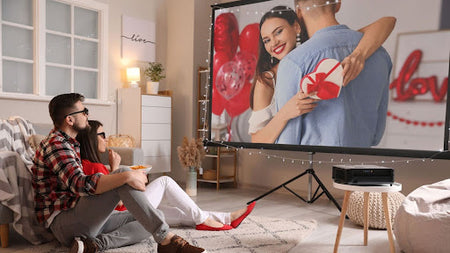In today's eco-conscious world, understanding the energy consumption of our gadgets is not just a matter of personal interest but a collective responsibility.
The purpose of this blog post is to shed light on the energy consumption patterns of projectors. Whether it's a cozy movie night at home or a professional presentation at work, knowing how much power your projector uses can lead to cost savings and a reduced environmental footprint. From the sleek, low-end portable models to the more powerful high-end theater systems, projectors come in a wide range of wattages and technologies, each with its unique power usage profile.
Let's embark on this enlightening journey to demystify the watts and whys of projector energy consumption, making our entertainment choices smarter and more sustainable.
How Many Watts Does a Projector Use?
Understanding the wattage of projectors is crucial for gauging their energy consumption, which directly impacts your electricity bill and environmental footprint. Projectors range widely in terms of power usage, primarily based on their design, technology, and intended use.
Low-End Portable Models
At the lower end of the spectrum, portable projectors are designed for convenience and occasional use, such as outdoor movie nights or small presentations. These models typically consume between 50 to 100 watts. Their compact size and efficiency make them an excellent choice for those prioritizing portability and low energy use.
Mid-Range Home Theater Projectors
Mid-range projectors, which are often used for home theaters or larger presentations, tend to consume more power, usually ranging from 150 to 300 watts. These projectors balance power with performance, offering higher brightness and better image quality than their portable counterparts, leading to increased energy use.
High-End Theater Systems
On the higher end, professional-grade theater projectors can consume upwards of 1000 watts, catering to large venues and commercial theaters requiring the highest brightness and best image quality. These projectors are designed for optimal performance but are less energy-efficient due to their high luminosity and advanced features.
Technology Type and Wattage
The technology behind the projector also plays a significant role in its energy consumption. LCD (Liquid Crystal Display) projectors typically use more power than DLP (Digital Light Processing) and LED (Light Emitting Diode) projectors due to their design and light source efficiency. LED projectors are generally the most energy-efficient, benefiting from lower power usage and longer lifespan of the LED light source.
Factors Influencing Projector Energy Usage
Projector energy usage is not a static figure; it varies significantly across different models and usage scenarios. Understanding the factors that influence how many watts a projector uses can help users optimize their device for lower energy consumption. Here are key factors that directly impact a projector's power usage:
Brightness (Lumens)
One of the most significant factors affecting a projector's energy consumption is its brightness, measured in lumens. Higher brightness projectors require more power to illuminate larger spaces vividly. While a brighter image is often desirable, especially in well-lit environments, it comes at the cost of increased energy usage. Selecting a projector with the appropriate brightness for your needs can help balance energy efficiency with performance.
Usage Hours
The amount of time a projector is used also plays a crucial role in its overall energy consumption. Regular use for extended periods, such as in classrooms, offices, or home theaters, will naturally lead to higher energy usage. Conscious use, turning off the projector when not in use, and utilizing eco-mode settings (where available) can help mitigate excessive power consumption.
Power Settings
Many projectors come equipped with power-saving modes that reduce energy consumption by lowering brightness or powering down the lamp when inactive. Utilizing these settings can significantly impact the projector's energy usage without substantially compromising performance for many use cases.
Technology Type
The technology behind a projector's image projection—LCD (Liquid Crystal Display), DLP (Digital Light Processing), or LED (Light Emitting Diode)—also influences its power consumption. LED projectors typically offer the best energy efficiency, benefiting from the lower power requirements of LED lighting. In contrast, LCD and DLP projectors may consume more power, though advancements in technology continue to improve their energy efficiency.
Environmental Conditions
External factors such as ambient light, room size, and projector placement can affect energy usage indirectly. Projectors used in brighter environments may need to operate at higher brightness levels to produce visible images, thereby consuming more power. Optimizing room conditions, such as using blackout curtains or positioning the projector optimally, can reduce the need for maximum brightness settings.
Frequently Asked Questions
Is it expensive to run a projector?
The cost of running a projector varies significantly based on the model's wattage and how frequently it is used. Low-end portable projectors, consuming between 50 to 100 watts, can be quite economical, especially for occasional use. On the other hand, high-end theater projectors, with their 1000+ watts consumption, can lead to higher electricity bills, particularly with regular use. By understanding your projector's wattage and using it judiciously, you can manage and minimize its running costs.
Does a projector use more electricity than a TV?
Comparing projectors and TVs in terms of electricity usage depends on several factors, including the devices' specifications and usage patterns. Generally, modern LED and OLED TVs are highly energy-efficient, often more so than mid-range to high-end projectors. However, low-end and some LED projectors can be comparable to or even surpass the energy efficiency of TVs, especially in settings where large displays are preferred.
How many watts is a good projector?
Defining a "good" projector in terms of wattage alone is misleading, as wattage is just one aspect of a projector's overall performance and suitability for a particular use. For casual or portable use, projectors with 50 to 100 watts can be adequate, offering a balance between energy efficiency and functionality. For home theaters or professional settings, projectors with higher wattage, typically in the range of 150 to 300 watts, provide better brightness and image quality. Ultimately, the best projector meets your specific needs while aligning with your energy consumption preferences.
Conclusion
Understanding the energy consumption of projectors is crucial for both environmental sustainability and cost management. By considering factors such as wattage, technology type, and usage patterns, users can select and operate projectors in a way that aligns with their values and requirements. Whether you're setting up a home theater, preparing for a professional presentation, or simply enjoying a movie night under the stars, being informed about your projector's power usage can lead to a more enjoyable and responsible viewing experience.



